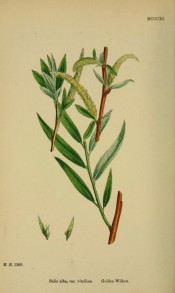Salix alba L. var. aurea Hort.
Salix alba is a fully hardy, fast-growing, spreading tree of conical habit with slender branches, drooping at the tips, with lance-shaped leaves, to 10cm long, yellow male catkins, to 5cm long, or stalkless, yellow-green female catkins, to 3cm long, produced in spring with the leaves. Aurea is a less vigorous tree with yellowish-green branches and pale yellow leaves. To 25m. [RHSE, Hilliers’].
Horticultural & Botanical History
No doubt an ancient garden plant. In its usual form its timber was much used for fencing and similar purposes. Salix alba var. vitellina, the Golden Willow, is figured in English Botany. [English Botany pl.MCCXI/1863-86]. The variety vitellina is the form generally called Golden Osier today and may be identical to aurea.
History at Camden Park
Listed in the 1845, 1850 and 1857 catalogues [T.916/1845].
Notes
Published Mar 25, 2009 - 02:36 PM | Last updated Mar 25, 2010 - 03:12 PM
| Family | Salicaceae |
|---|---|
| Category | |
| Region of origin | Europe, North Asia, North Africa. The form aurea is of garden origin. |
| Synonyms |
|
| Common Name | White willow, Golden osier |
| Name in the Camden Park Record | Salix aurea - Golden osier |
| Confidence level | high |


